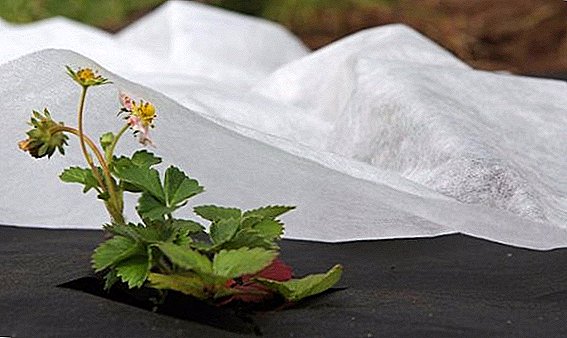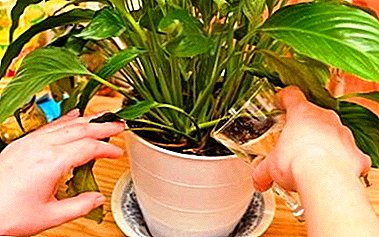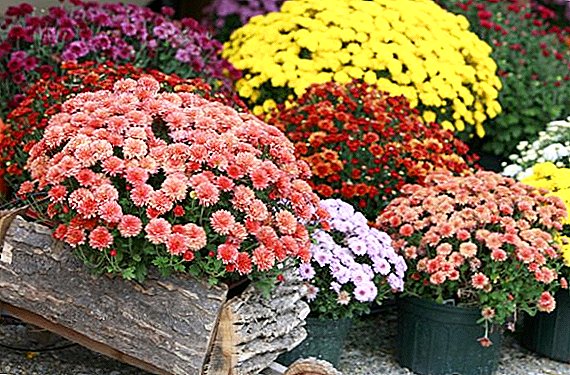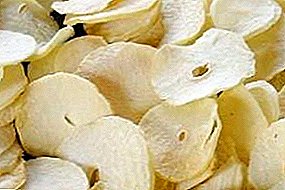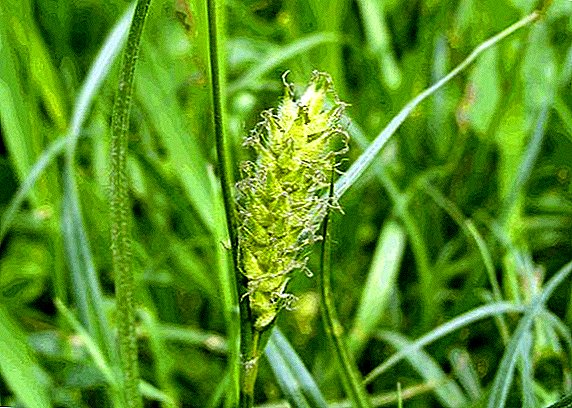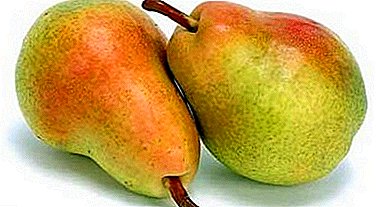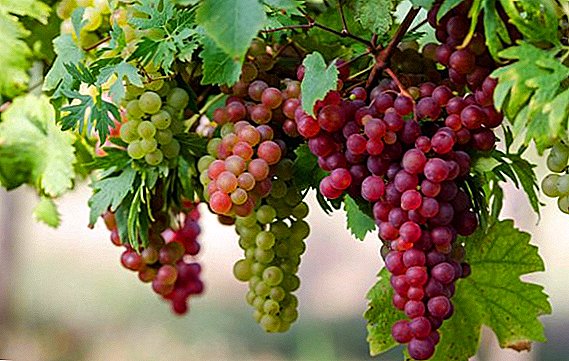 Today we will talk about how to water and feed the grapes in spring. Many owners who have been engaged in the cultivation of grapes for decades, are accustomed to a certain care for the vine. However, the climate is changing, and the weather conditions together with the lack of the required amount of nutrients reduce the crop yield and "award" grapes with various diseases. We will understand what kind of watering the grapes need in the spring, and whether it is worth making a large amount of fertilizing with organic fertilizers.
Today we will talk about how to water and feed the grapes in spring. Many owners who have been engaged in the cultivation of grapes for decades, are accustomed to a certain care for the vine. However, the climate is changing, and the weather conditions together with the lack of the required amount of nutrients reduce the crop yield and "award" grapes with various diseases. We will understand what kind of watering the grapes need in the spring, and whether it is worth making a large amount of fertilizing with organic fertilizers.
Basics of watering grapes in spring
Let's start with the watering of grapes in spring, which is carried out in certain periods and, as a rule, in various ways.
When to start
With the irrigation of vineyards in spring, everything is not so clear. The fact is that if the ground is not sufficiently wet after wintering (winters with little snow), then watering irrigation should be carried out. This is not just moisturizing the upper part of the ground, but “supplying” moisture to a depth.
Important! Water-charging irrigation is carried out both in spring and autumn, if the soil is devoid of moisture.
Water should be poured in trenches and drainage holes in the amount of 200-300 liters per bush. Such an abundance of water will moisturize the dry land and allow the vineyards to quickly wake up after the winter.
Check out such grape varieties as "Gala", "Annie", "Helios", "Talisman", "Chameleon", "Moldova", "Zabava", "Novocherkassk Anniversary", "Arcadia", "Augustine", "Kesha" "," Delight "," Lily of the Valley. "If the soil is saturated with moisture, then carry out such irrigation is not just undesirable, but strictly prohibited, because by pouring excess fluid into the soil, you displace oxygen from it, as a result of which the roots cannot breathe normally.
Important! Watering is carried out with warm water to accelerate the formation of kidneys. If the process needs to be slowed down, then cold water is supplied to the irrigation system.Obligatory spring watering is carried out 20 days before flowering. In each region, flowering may occur at different times, so the exact date we will not specify. You can water directly under the root, if planting occupy a small area. If the vineyards are occupied by several dozen acres of land, then we supply moisture through trenches and drainage pipes. Application rate - 200 liters per bush. We figured out when to water the grapes in the spring, then we will talk about drought tolerance of the crop.
Does grapes like moisture?
Grapes are quite moisture-loving plants, which requires a huge amount of water during irrigation, but an overabundance of moisture has a more negative effect than its lack.
The fact is that if the vine does not receive enough moisture when watering, then its roots begin to go deep into the soil in search of water. If there is no clay layer in your region that will not allow the roots to go deeper, then you need not worry that the grapes will dry in particularly hot weeks.
It will be useful for you to learn about common diseases of grapes, especially about itching and mildew.Not only the stability of the vine, but also the degree of protection depends on the deepening of the root system. If the plant receives a sufficient amount of water during systematic irrigation, then the grape develops a superficial root system, which in the case of severe frosts will instantly freeze, and the culture will die.
 If the lack of moisture causes the roots to go a few meters deep, even severe frosts will not lead to the complete destruction of the plant.
If the lack of moisture causes the roots to go a few meters deep, even severe frosts will not lead to the complete destruction of the plant.It turns out a kind of dilemma: to give the grapes the right amount of water and get a good harvest without risking the vineyards once more, or to test the strength, which will protect the crop from freezing rhizomes.
Important! Vine can withstand temperatures up to 30°C, however, any greens will freeze even with minimal frosts.
Irrigation methods
There are two main ways to irrigate grapes:
- surface;
- underground.
Surface irrigation method is divided into the following variations:
- drip irrigation;
- supply of water to common ditches;
- irrigation of single pits, which are located near each bush.

Drip irrigation suitable for craftsmen who have enough time and knowledge to build such a system. Pipes for watering can be pulled both on a hanging wire and on the ground. This option is best suited for heavy soils that do not allow air to pass through.
Watering through a common ditch. Suitable for large grape plantations, when it is practically impossible to water each bush separately. This option does not require equipment costs, but the use of water for irrigation can not be called rational.
Learn also how to cut grapes in spring.Watering single pits. The best option that is suitable for a small planting vines. Humidifying in this way, though not conserving water, as in the case of drip, however, each individual plant will receive its norm.
Now let's discuss underground moistening, which is also very popular and has several options for implementation:
- vertical holes;
- horizontal pipes.
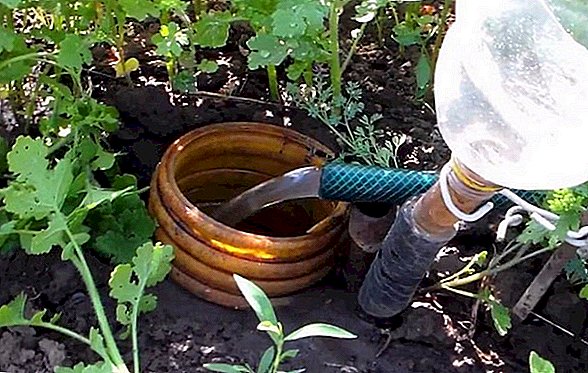
Vertical tube. The point is that near each bush (indented 1 m from the trunk) a hole is dug into which a plastic pipe is inserted. Throughout the length of the pipe, holes are made through which moisture will seep into the soil. To prevent the holes from clogging, pits of rubble or gravel are piled around the pits. The water supply is carried out with a hose or manually pouring water.
Horizontal tube. The most popular method that has recently been used everywhere. The popularity is due to the fact that not only water but also various liquid fertilizers can be supplied through an underground horizontal pipe.
The pipe is placed at a depth of 60-70 cm. A hole is made through each meter into which liquid will flow. All openings are closed with agrofibre or fine mesh to protect against clogging. A sufficient capacity is connected to the system, into which water or a mixture of fertilizers is poured, then the liquid is heated in the sun and enters through pipes.
Did you know? In medicine, there is such a thing as "ampelotherapy" - treatment with grapes, and not only berries, but also leaves, wood, and everything that can be taken from this plant.
Features feeding grapes in spring
We turn to spring dressing of grapes: we will discuss options for dressing, dates and methods of introduction. Let's talk about how important spring dressings are for creepers. 
Mineral fertilizers and organic
Let's start with the fact that the fertilizer, planted when planting a young bush, lasts only for 3-4 years, then mineral starvation begins, and the plant is simply not able to produce the desired crop without additional fertilizer.
Learn more about which drugs to use for the vineyard.Fertilizers applied by culture are divided into two groups:
- the main ones;
- additional.
Major fertilizers are applied once every 2-3 years. Sealing is carried out in early spring or autumn. Fertilized with a mixture of organic and mineral water. Additional fertilizers are rather a kind of insurance against adverse weather conditions and pathogenic organisms. The most commonly used liquid options.
What is better: organic or mineral water?
For grapes, natural organic supplements are preferred, which are carried out by applying manure, compost, peat or bird droppings. This type of fertilizer not only gives the vine all the necessary minerals and nutrients, but also adjusts the consistency of the soil, making it more crumbly and breathable.
Mineral fertilizers also have considerable benefits, so they can be used together with organic matter. "Mineral water", which incorporates the NPK group (nitrogen, phosphorus, potassium), is best suited, since this complex solves all the problems of vines at any stage of development.
It is worth remembering that if you use only organic fertilizers, then there is no special need for mineral fertilizers. However, if you feed the plants only with mineral fertilizers, then they will experience a shortage of various substances.
Did you know? For the production of one bottle of wine, on average, you need 600 grapes.It turns out that organic matter is indispensable, therefore, every year it is imperative to apply a dose of organic fertilizer.

Terms of making dressings
Top dressing for grapes in the spring is made in certain terms about which you need to know and adhere to them.
After winter, before removing the film or any other shelter from the vineyards, you need to feed the bushes with a mixture of superphosphate, ammonium nitrate and potash salt (or use a complex fertilizer). In 1 liter we dilute 2 g of superphosphate, 1 g of nitrate and 0.5 g of potassium salt. For watering a bush, you must use about 10 liters of this solution.
The following application of fertilizing is carried out 15 days before the start of flowering. Use the same mixture with the same concentration (2: 1: 0.5 per 1 liter).
Important! The last feeding must be carried out no later than 15 days before harvesting.In the summer they make another additional feeding, excluding the nitrogen component.

Ways to make
Standard use root dressing, which involves the application of fertilizers in pristvolny circle. Both single pits and a continuous trench can be excavated. The seeding depth is 40-50 cm. It is better to use this method in the fall, before sheltering for the winter.
Another option for fertilizer application is foliar dressing, which, although not able to replace the basic variant, however, helps plants at different stages. Extra root top dressings are brought in by drip irrigation or irrigation from sprinklers or a spray bottle. For these purposes, not only 3 standard mineral elements are used, but also additional compounds, which include bromine, cobalt, manganese, copper, and others. It is worth saying that root dressing is basic: without it, the plant will lack basic minerals and nutrients, since fertilizers embedded in the soil are best absorbed by the root system.
This concludes the discussion of spring watering and feeding vineyards on your site. Use the suggested instructions to provide your plantings with the right amount of moisture and nutrients for optimal growth and fruit formation.



